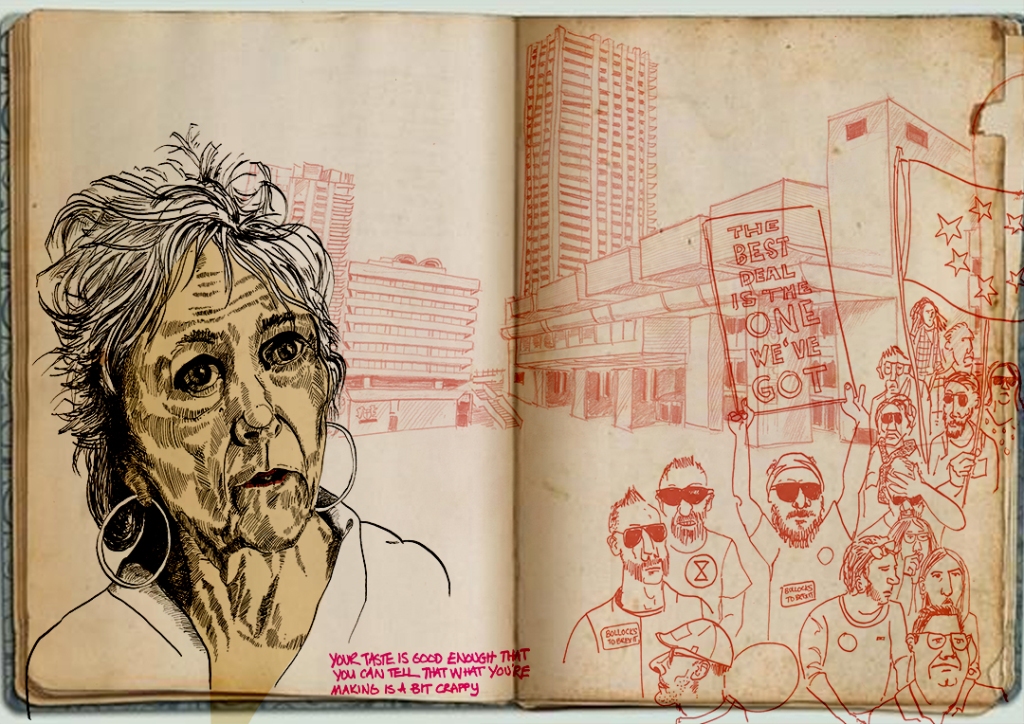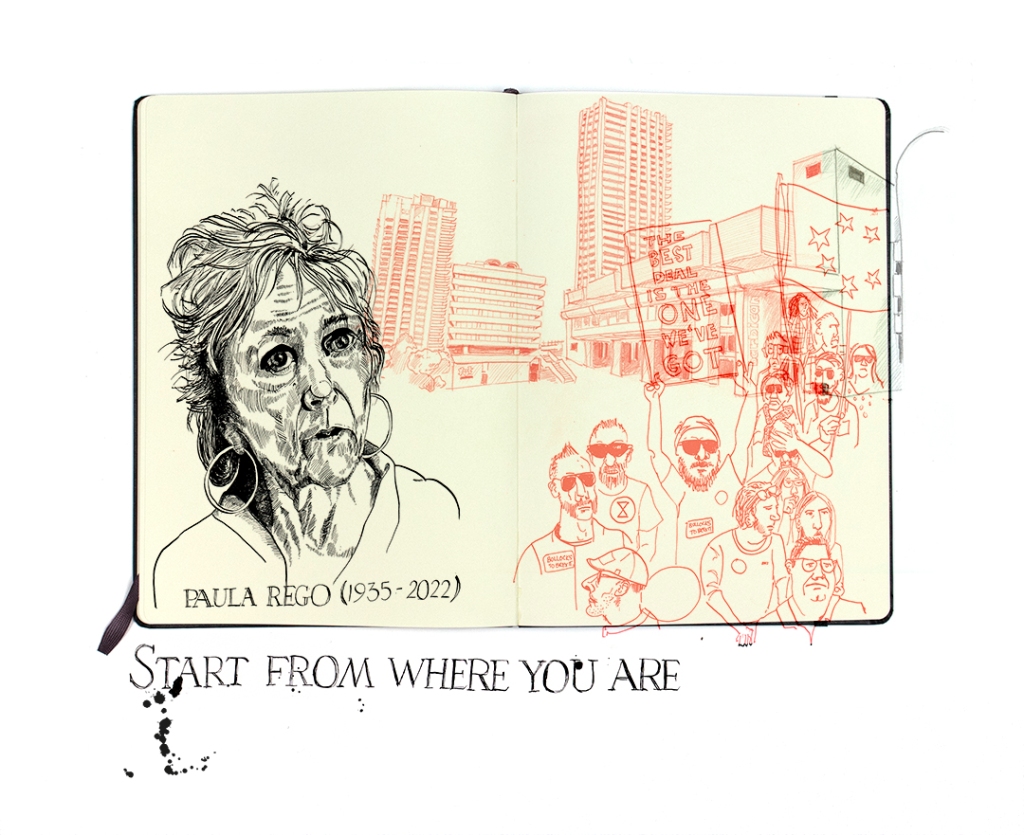The purpose of this exercise was to think about and understand how and where my work sits within a contemporary context through the creation of a series of illustrations/information graphics.
Key words from the brief`:
- Consider your present ideas on creativity, your immediate history and reflect further back into the canon of art and design history.
- Curate a line of 10 key events that have formed your creative position.
- A creative statement that presents an argument for your position.
- Produce a piece of information design that presents your chronological line of 10 key moments.
What is my creative position?
My current ideas on creativity:
Principles
- Design is most important
- Take risks, fail fast, learn fast
- Pay attention to what you pay attention to
- Do a lot of work
- Don’t be a dick
- Respect copyright and acknowledge the work of others
Why
- A way of working things out
- My way of expressing myself in the the world
- Storytelling
- Joy in the act of creation
What
Common threads that run throughout my work:
- Curiosity
- People
- Places
- The slightly strange
Where does my practice sit within a contemporary context?
I work in a number of genres: reportage, portraiture, visual diaries and comic books. I recognise that I need to narrow this down to strengthen my portfolio, although I don’t know how I’ll do this yet.
Foundations: Observational drawing, experimentation, striving for technical excellence and a disregard for formal rules.
Research and analysis
The brief does not specify an audience or context for these illustrations so I interpreted this as a personal brief where the main audience was myself and my tutor. I used it as an opportunity to experiment with technical and creative aspects of my practice as well as a way to explore my own creative background and drive.
In November 2021 I attended a workshop run by the AOI titled What’s your brand story. The session was facilitated by brand specialist Nicola Mullen. The purpose of the workshop was to support attendees to understand your brand better and celebrate and articulate what you’re about in the best possible way (Mullen, 2021), which is closely aligned with PART 1 Proposal manifesto objectives.
After attending, I explored other self branding tools and discovered two exercises that particularly resonated with me involving a look backwards across my life in order to answer two questions:
- Who have you been throughout your life as a cultural receiver?
- As you think about your whole life, who were you as a creative being?
I was interested in see what connections I could make across time that would give insight into my current practice.
I used two mindmaps to explore these questions, dividing my life into decades. This was fascinating and engaging and generated a lot of content, (that I’m not reproducing here because some of it is quite personal.
I added and amended the mindmaps over several days.
The next step was to analyse the results using questions that are captured in the mindmaps below.
Key cultural influences

Who were you as a creative being?

One of the outputs from this exercise was a ‘bucket’ of content organised by decade that I could use as subjects for my illustrations.
There are close parallels between this approach of collecting, organising and curating content and the process I used to generate a series of screen prints from my pandemic diary content.
Content selection
The work was autobiographical and content was broadly organised chronologically, in the order in which I experienced them.
There were three type of content:
- Key cultural influences: people, events, places, influences
- Texts that summarise key creative realisations/principles
- Captions of people/characters/events
Artist research
I’d recently completed the research task 1.2 Ten practitioners, and with this fresh in my mind looked at the work of two of the practitioners for inspiration.
I noticed a series of illustrations on Olivia Kulger’s website portfolio that were quite different to his usual reportage documentary output. I liked the text/image combination presented in a notebook format. Readers have to build their own interpretation of the narrative within each image based on basic visual and information.

Dave McKean produced a series of books recording his impressions of places. The image below is from Postcard from Barcelona (McKean, 2007). As well as his mastery of drawing I was interested in how he combined different drawings and texts together into composite images across double pages.

Combining different text and visual content together reminded me of tutor feedback related to an Illustration 1 poster design exercise where it was suggested that I should refer to Paul Frehm Ripley’s Believe It or Not! (Scoop, 2022).

Generating ideas
Visual experiments
The images included here are experiments in techniques and media that enabled me to select the visual approaches that I took forward into the final artwork.
Design
Through the combination of practice research and artist research I realised that what I would like to achieve in the final artwork is a fusion of different content elements organised chronologically in decades.
This would include:
- Controlled pen and ink portraits. Tightly drawn aiming for likeness and accuracy
- Looser more expressive drawings using drawing ink and/or a paint brush
- Handwritten/illustrated lettering inspired by the illustrative stye of David Hughes
I was hoping that this approach would begin the answer the question posed at the end of my pandemic diary Critical Review: “how I apply this new found ‘voice’ to more direct briefs” (Hadfield, 2022).
I thumbnailed ideas based on the content combinations I’d shortlisted.


Then created a mock-up and experimented by introducing the idea of an open sketchbook as a visual vehicle to display the images. I liked this because it emphasised that my work is based on a foundation of observational drawing.

I discussed the mock-up with my tutor and she asked whether, in teh final artwork, the drawings would continue to bleed beyond the edges of the sketchbook. My immediate reaction was that they would be cropped to fit, but after discussion wanted to explore the idea using this as a compositional device.
Artwork
Artwork was created over several weeks on paper, with final artwork composited together in Photoshop.
I created five images:





Reflections
- This exercise was an interesting way to identify and reflect on where different elements of my creative interests come from and what it is about them that I find interesting.
- Drawing a likeness in the portraits felt like a risk. Although not perfect I feel more confident that I can achieve this.
References
Citations
Hadfield, Hugh (2022) When a cataclysmic event turns the world upside down, how do artists respond? In possession of: The author p 53
Mullen, Nicola (2021) What is you brand story? At: https://smallfrycollective.com/whats-your-brand-story (Accessed: 21/07/22)
List of illustrations
Figure 1 – Hadfield, Hugh (2022) Cultural influences mindmap [Digital] In possession of: The author
Figure 2 – Hadfield, Hugh (2022) Creative being mindmap [Digital] In possession of: The author
Figure 3 – Kulgar, Olivier For Dockers Clothing At: http://www.olivierkugler.com/c39/index.html (Accessed: 24/06/22)
Figure 4 – McKean, Dave (2006) Illustrations of people In: Mckean, Dave (2007) Postcard from Barcelona California, Hourglass/Allen Spiegel Fine Arts in 2006. p.11-12
Figure 5 – Scoop, (2022) Creator Profile: Charles M. Schulz At: https://scoop.previewsworld.com/Home/4/1/73/1013?articleID=237499 (Accessed: 21/07/22)
Figure 6 – Hadfield, Hugh (2022) Testing layout and content combinations [Fountain pen] In possession of: The author
Figure 7 – Hadfield, Hugh (2022) Further thumbnail combinations [Fountain pen] In possession of: The author
Figure 8 – Hadfield, Hugh (2022) Mock-up testing visual approach [Mixed media and digital] In possession of: The author
Figure 9 – Hadfield, Hugh (2022) First key moments [Mixed media and digital] In possession of: The author
Figure 10 – Hadfield, Hugh (2022) Second key moments [Mixed media and digital] In possession of: The author
Figure 11 – Hadfield, Hugh (2022) Third key moments [Mixed media and digital] In possession of: The author
Figure 12 – Hadfield, Hugh (2022) Fourth key moments [Mixed media and digital] In possession of: The author
Figure 13 – Hadfield, Hugh (2022) Fifth key moments [Mixed media and digital] In possession of: The author









